Indonesia
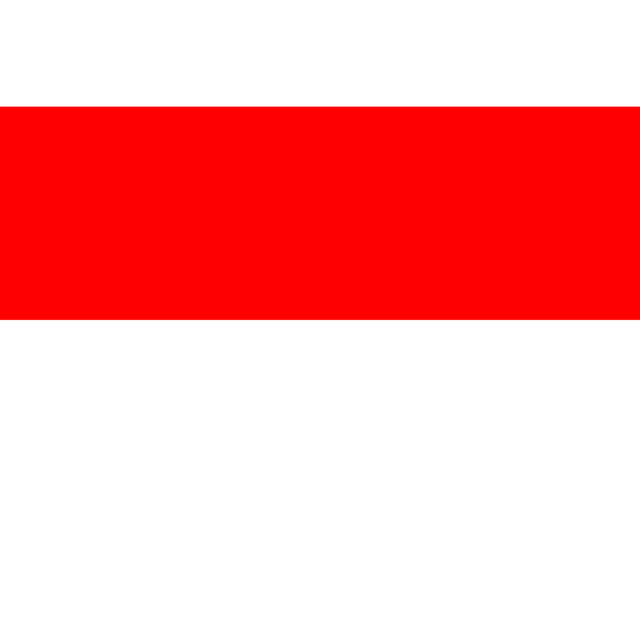
Indonesia

| Capital | Jakarta |
|---|---|
| Official language | Indonesian |
| Over700 languages[6] | |
| Ethnic groups | Over[786]ethnic groups |
| Religion | |
| Demonym(s) | Indonesian |
| Government | Unitarypresidential constitutional republic |
| Joko Widodo | |
| Jusuf Kalla | |
| Bambang Soesatyo | |
| Muhammad Hatta Ali | |
| Legislature | People's Consultative Assembly(MPR) |
| Regional Representative Council(DPD) | |
| People's Representative Council(DPR) | |
| Formation | |
| 2nd century | |
| 13th century | |
| 20 March 1602 | |
| 1 January 1800 | |
| 9 March 1942 | |
| 17 August 1945 | |
| 27 December 1949 | |
| 17 August 1950 | |
| Area | |
| 1,904,569[9]km (735,358 sq mi) (14th) | |
| 4.85 | |
| Population | |
| 261,115,456[10] | |
| 237,641,326[11](4th) | |
| 138/km (357.4/sq mi) (88th) | |
| GDP | 2019 estimate |
| GDP | 2019 estimate |
| Gini | |
| HDI | |
| Currency | Indonesian rupiah(Rp) (IDR) |
| Time zone | (various) |
| Date format | DD/MM/YYYY |
| Driving side | left |
| Calling code | +62 |
| ISO 3166 code | ID |
| Internet TLD | .id |
Indonesia (/ˌɪndəˈniːʒə/ ( listen) IN-də-NEE-zhə, /-ˈniːziə/ -NEE-zee-ə; Indonesian: [ɪndoˈnesia]), officially the Republic of Indonesia (Indonesian: Republik Indonesia [reˈpublik ɪndoˈnesia]),[1] is a country in Southeast Asia, between the Indian and Pacific oceans. It is the world's largest island country, with more than seventeen thousand islands,[14] and at 1,904,569 square kilometres (735,358 square miles), the 14th largest by land area and 7th in the combined sea and land area.[15] With over 261 million people, it is the world's 4th most populous country as well as the most populous Muslim-majority country.[16] Java, the world's most populous island,[17] is home to more than half of the country's population.
The sovereign state is a presidential, constitutional republic with an elected legislature. It has 34 provinces, of which five have special status. Jakarta, the country's capital, is the second-most populous urban area in the world. The country shares land borders with Papua New Guinea, East Timor, and the eastern part of Malaysia. Other neighbouring countries include Singapore, Vietnam, the Philippines, Australia, Palau, and India's Andaman and Nicobar Islands. Despite its large population and densely populated regions, Indonesia has vast areas of wilderness that support a high level of biodiversity.[18] The country has abundant natural resources like oil and natural gas, coal, tin, copper, gold, and nickel, while agriculture mainly produces rice, palm oil, tea, coffee, cacao, medicinal plants, spices, and rubber.[19] China, the United States, Japan, Singapore, and India are Indonesia's major trading partners.[20]
The history of the Indonesian archipelago has been influenced by foreign powers drawn to its natural resources. It has been a valuable region for trade since at least the 7th century when Srivijaya and then later Majapahit traded with entities from mainland China and the Indian subcontinent. Local rulers gradually absorbed foreign influences from the early centuries and Hindu and Buddhist kingdoms flourished. Muslim traders and Sufi scholars brought Islam,[21][22] while European powers brought Christianity and fought one another to monopolise trade in the Spice Islands of Maluku during the Age of Discovery. Although sometimes interrupted by the Portuguese, French and British, the Dutch were the foremost European power for much of their 350-year presence in the archipelago. In the early 20th century, the concept of "Indonesia" as a nation-state emerged, and independence movements began to take shape.[23] During the decolonisation of Asia after World War II, Indonesia achieved independence in 1949 following an armed and diplomatic conflict with the Netherlands.
Indonesia consists of hundreds of distinct native ethnic and linguistic groups, with the largest—and politically dominant—ethnic group being the Javanese. A shared identity has developed, defined by a national language, ethnic diversity, religious pluralism within a Muslim-majority population, and a history of colonialism and rebellion against it. Indonesia's national motto, Bhinneka Tunggal Ika" ("Unity in Diversity" literally, "many, yet one"), articulates the diversity that shapes the country. Indonesia's economy is the world's 16th largest by nominal GDP and 7th by GDP at PPP. The country is a member of several multilateral organisations, including the UN,[2] WTO, IMF, G20, and a founding member of Non-Aligned Movement, Association of Southeast Asian Nations, Asia-Pacific Economic Cooperation, East Asia Summit, Asian Infrastructure Investment Bank, and Organisation of Islamic Cooperation.
| Capital | Jakarta |
|---|---|
| Official language | Indonesian |
| Over700 languages[6] | |
| Ethnic groups | Over[786]ethnic groups |
| Religion | |
| Demonym(s) | Indonesian |
| Government | Unitarypresidential constitutional republic |
| Joko Widodo | |
| Jusuf Kalla | |
| Bambang Soesatyo | |
| Muhammad Hatta Ali | |
| Legislature | People's Consultative Assembly(MPR) |
| Regional Representative Council(DPD) | |
| People's Representative Council(DPR) | |
| Formation | |
| 2nd century | |
| 13th century | |
| 20 March 1602 | |
| 1 January 1800 | |
| 9 March 1942 | |
| 17 August 1945 | |
| 27 December 1949 | |
| 17 August 1950 | |
| Area | |
| 1,904,569[9]km (735,358 sq mi) (14th) | |
| 4.85 | |
| Population | |
| 261,115,456[10] | |
| 237,641,326[11](4th) | |
| 138/km (357.4/sq mi) (88th) | |
| GDP | 2019 estimate |
| GDP | 2019 estimate |
| Gini | |
| HDI | |
| Currency | Indonesian rupiah(Rp) (IDR) |
| Time zone | (various) |
| Date format | DD/MM/YYYY |
| Driving side | left |
| Calling code | +62 |
| ISO 3166 code | ID |
| Internet TLD | .id |
Etymology
The name Indonesia derives from the Greek name of the Indos*]]Ἰνδός) and the wordos* (νῆσος), meaning "Indian islands."[24] The name dates to the 18th century, far predating the formation of independent Indonesia.[25] In 1850, George Windsor Earl, an English ethnologist, proposed the terms Indunesians—and, his preference, Malayunesians—for the inhabitants of the "Indian Archipelago or Malayan Archipelago."[26] In the same publication, one of his students, James Richardson Logan, used Indonesia as a synonym for Indian Archipelago.[27][28] However, Dutch academics writing in East Indies publications were reluctant to use Indonesia; they preferred Malay Archipelago (Maleische Archipel); the Netherlands East Indies (Nederlandsch Oost Indië), popularly Indië; the East (de Oost); and Insulinde.[29]
After 1900, Indonesia became more common in academic circles outside the Netherlands, and native nationalist groups adopted it for political expression.[29] Adolf Bastian, of the University of Berlin, popularised the name through his book Indonesien oder die Inseln des Malayischen Archipels, 1884–1894. The first native scholar to use the name was Ki Hajar Dewantara when in 1913 he established a press bureau in the Netherlands, Indonesisch Pers-bureau.[25]
History
Early history
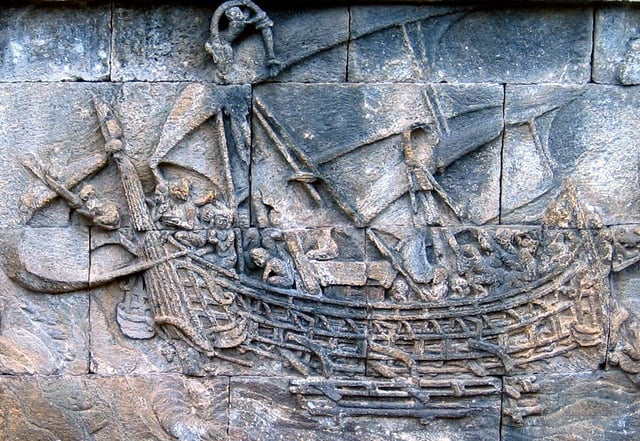
A Borobudur ship carved on Borobudur temple, c. 800 CE. Outrigger boats from the archipelago may have made trade voyages to the east coast of Africa as early as the 1st century CE.[30]
Based on fossils and the remains of tools, Homo erectus, known as "Java Man", inhabited the Indonesian archipelago between 1.5 million and 33,000 BCE.[31][32][33] Homo sapiens reached the region around 43,000 BCE.[34] Austronesian peoples, who form the majority of the modern population, migrated to Southeast Asia from what is now Taiwan. They arrived around 2,000 BCE, and as they spread through the archipelago, confined the indigenous Melanesians to the far eastern regions.[35] Ideal agricultural conditions and the mastering of wet-field rice cultivation as early as the 8th century BCE[36] allowed villages, towns, and small kingdoms to flourish by the first century CE. The archipelago's strategic sea-lane position fostered inter-island and international trade, including links with Indian kingdoms and Chinese dynasties, which had existed since several centuries BCE.[37] Trade has since fundamentally shaped Indonesian history.[38][39]
From the first until the 16th century CE, the archipelago was home to a series of Hindu-Buddhist polities.[40] From the 7th century, the Srivijaya naval kingdom flourished as a result of trade along with the influences of Hinduism and Buddhism.[41] The agricultural Buddhist Sailendra and Hindu Mataram dynasties thrived and declined in inland Java, leaving grand religious monuments such as Borobudur, Sewu and Prambanan between the 8th and 10th century. This period marked a renaissance of Hindu-Buddhist art in ancient Java.[42] The late 13th century saw the founding of the Hindu Majapahit kingdom in eastern Java. It was one of the most powerful empires in Southeast Asia, and under Gajah Mada, its influence stretched over much of present-day Indonesia.[43]
The earliest evidence of a Muslim population in the archipelago dates to the 13th century in northern Sumatra, although Muslim traders first travelled through Southeast Asia early in the Islamic era.[44] Other parts of the archipelago gradually adopted Islam, and it was the dominant religion in Java and Sumatra by the end of the 16th century. For the most part, Islam overlaid and mixed with existing cultural and religious influences, which shaped the predominant form of Islam in the archipelago, particularly in Java.[45]
Colonial era
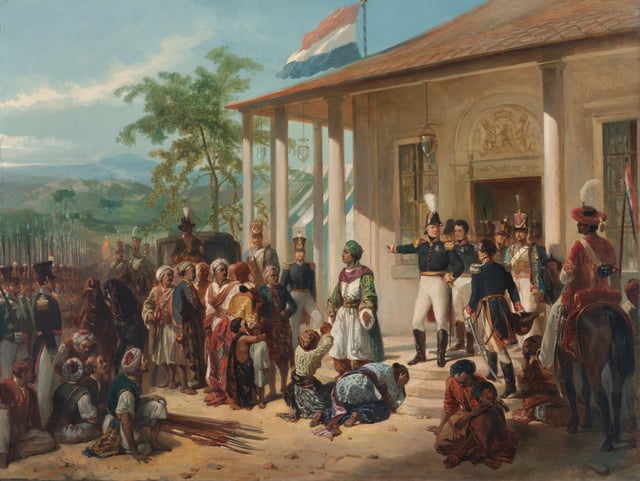
The submission of Prince Diponegoro to General De Kock at the end of the Java War in 1830
The first regular contact between Europeans and the peoples of the archipelago began in 1512, when Portuguese traders, led by Francisco Serrão, sought to monopolise the sources of nutmeg, cloves, and cubeb pepper in Maluku.[46] Dutch and British traders followed. In 1602, the Dutch established the Dutch East India Company (VOC), and in the following decades, they gained a foothold in Batavia and Amboina. For almost 200 years, the company was the dominant European power in the archipelago.[47] It dissolved in 1800 following bankruptcy, and the Netherlands established the Dutch East Indies as a nationalised colony.[48]
Since the VOC's establishment, trade had been the primary motivation behind the enlargement of Dutch territory.[49][50] Starting from 1840, the Dutch began a period of expansion, this time to protect areas already held and to prevent intervention from other European powers.[50] As a result, they became involved in conflicts against various native groups throughout the 19th century, such as the Padri War, Java War, and Aceh War.[51][52][52] It was only in the early 20th century that the Dutch exerted control over what was to become Indonesia's current boundaries,[53] with the addition of Western New Guinea in 1920.
In 1901, the Netherlands introduced the Dutch Ethical Policy, which had the purpose of improving living conditions and welfare, expanding education to native peoples,[54] and preparing the archipelago for self-government under Dutch control.[55]Between%20Two%20Worlds%3A%20Et]] [56]World War II occupied the archipelago[57][58][59] the Japanese encouraged and facilitated Indonesian nationalism, promoted nationalists such as Sukarno, Mohammad Hatta, and Ki Hajar Dewantara, and provided weapons and military training.[56]
Modern era
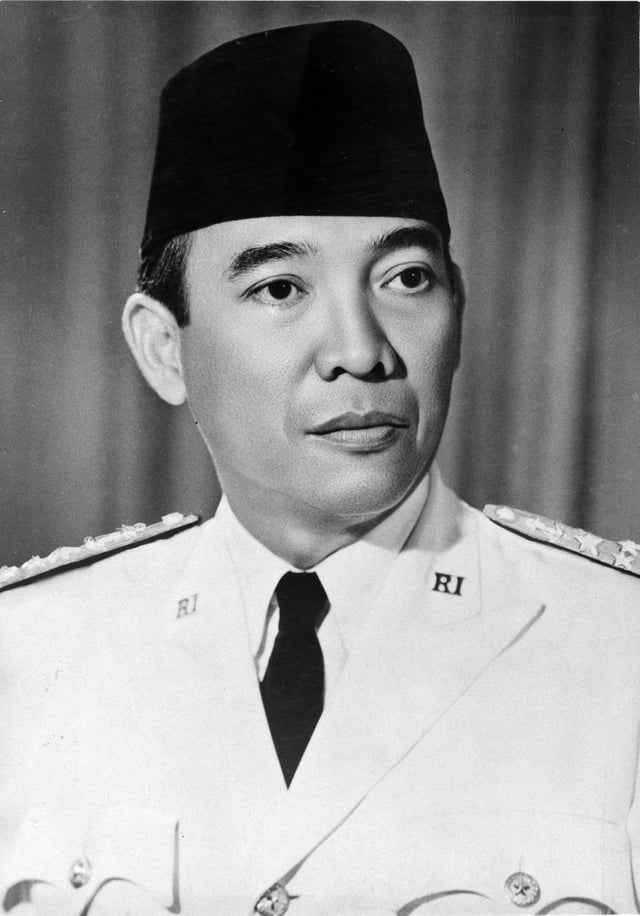
Sukarno, the founding father and first President of Indonesia
Two days after the surrender of Japan, Sukarno and Hatta proclaimed Indonesian independence on 17 August 1945[60][61] and were selected as the country's first President and Vice-President respectively. The Netherlands attempted to re-establish their rule, and an armed and diplomatic struggle ensued. On 27 December 1949, the Dutch formally recognised Indonesian independence in the face of international pressure,[62] except for the Netherlands New Guinea, which is subject to ongoing Papua conflict.[63] Despite extraordinary internal political, social and sectarian divisions, Indonesians, on the whole, found unity in their fight for independence.
In the late 1950s, Sukarno moved Indonesia from democracy towards authoritarianism and maintained his power base by balancing the opposing forces of the military and the Communist Party of Indonesia (Partai Komunis Indonesia, PKI).[64] An attempted coup on 30 September 1965 was countered by the army, which led a violent purge that left at least 500,000 people killed,[65] and the PKI officially blamed for the coup and effectively destroyed.[66][67][68] The head of the military, General Suharto, outmanoeuvred the politically weakened Sukarno and was appointed president on 27 March 1968. His New Order administration,[69] supported by the United States,[70][71][72] encouraged foreign direct investment,[73][74] which was a crucial factor in the subsequent three decades of substantial economic growth. However, rampant corruption was widespread, as well as the suppression of political opposition.[75][75][75] On 7 December 1975, Indonesia invaded and annexed neighbouring former Portuguese colony, East Timor.[78]
The 1997 Asian financial crisis, which hit Indonesia particularly hard,[79] brought an end to the New Order in 1998,[80] and subsequently, the occupation of East Timor. In the post-Suharto era, strengthening of democracy has included a regional autonomy programme and the first direct presidential election in 2004.[81] Political, economic and social instability, corruption, and terrorism slowed progress; however, in recent years, the economy has performed strongly. Relations among the diverse population are mostly harmonious, though sectarian discontent and violence have persisted.[82] Indonesia was the worst-hit country by the 2004 Indian Ocean earthquake and tsunami that killed around 130,000 people, mainly in Aceh.[83] The aftermath of the disaster played a part in achieving political settlement to the region's insurgency in 2005.[84]
At the conclusion of the 2014 presidential election, Joko Widodo, also known as Jokowi, emerged victorious as the first president outside the military and political elite.[85] His administration has emphasised the building and improvement of public infrastructure, social programs, and the country's overall economic standing.[86] In 2019, Jokowi announced that the province of East Kalimantan on Borneo would be the site for the new capital city, realising a plan that has been around since the 1950s.[87]
Geography
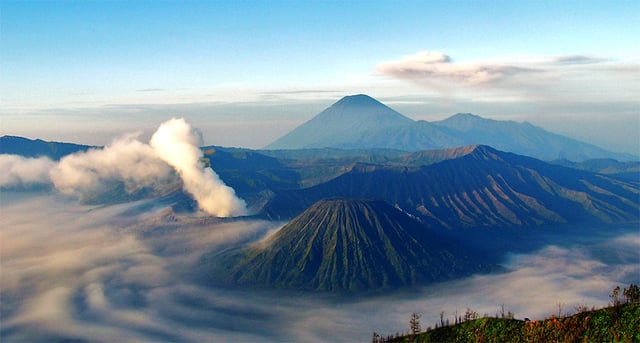
Mount Semeru and Mount Bromo in East Java. Indonesia's seismic and volcanic activity is among the world's highest.
Indonesia lies between latitudes 11°S and 6°N, and longitudes 95°E and 141°E. It is the largest archipelagic country in the world, extending 5,120 kilometres (3,181 mi) from east to west and 1,760 kilometres (1,094 mi) from north to south.[88] According to the country's Coordinating Ministry for Maritime Affairs, Indonesia has 17,504 islands (16,056 of which are registered at the UN),[14] scattered over both sides of the equator, and with about 6,000 of them inhabited.[89] The largest are Java, Sumatra, Borneo (shared with Brunei and Malaysia), Sulawesi, and New Guinea (shared with Papua New Guinea). Indonesia shares land borders with Malaysia on Borneo, Papua New Guinea on the island of New Guinea, and East Timor on the island of Timor, and maritime borders with Singapore, Malaysia, Vietnam, the Philippines, Palau, and Australia.
At 4,884 metres (16,024 ft), Puncak Jaya is Indonesia's highest peak, and Lake Toba in Sumatra is the largest lake, with an area of 1,145 km2 (442 sq mi). Indonesia's largest rivers are in Kalimantan and New Guinea and include Kapuas, Barito, Mamberamo, Sepik and Mahakam. They serve as communication and transport links between the island's river settlements.[90]
Climate
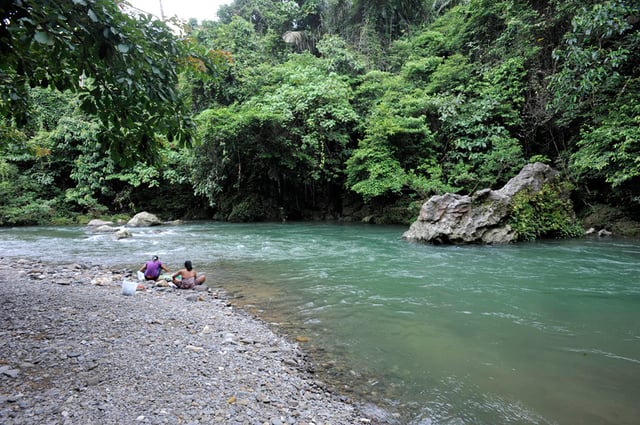
Typical Indonesian rainforest, mostly found in Kalimantan and Sumatra

Köppen-Geiger climate classification map for Indonesia[93]
Indonesia lies along the equator, and its climate tends to be relatively even year-round.[91] Indonesia has two seasons—a wet season and a dry season—with no extremes of summer or winter.[92] For most of Indonesia, the dry season falls between April and October with the wet season between November and March.[92] Indonesia's climate is almost entirely tropical, dominated by the tropical rainforest climate found in every large island of Indonesia. The tropical monsoon climate predominantly lies along Java's coastal north, Sulawesi's coastal south and east, and Bali, while the tropical savanna climate lies in isolated parts of Central Java, lowland East Java, coastal southern Papua and smaller islands to the east of Lombok. More cooling climate types do exist in mountainous regions that are 1,300 to 1,500 metres (4,300 to 4,900 feet) above sea level. The oceanic climate (Köppen Cfb) prevails in highland areas adjacent to rainforest climates, with reasonably uniform precipitation year-round. In highland areas near the tropical monsoon and tropical savanna climates, the subtropical highland climate (Köppen Cwb) is prevalent with a more pronounced dry season.
Some regions, such as Kalimantan and Sumatra, experience only slight differences in rainfall and temperature between the seasons, whereas others, such as Nusa Tenggara, experience far more pronounced differences with droughts in the dry season, and floods in the wet. Rainfall is plentiful, particularly in West Sumatra, West Kalimantan, West Java, and Papua. Parts of Sulawesi and some islands closer to Australia, such as Sumba are drier. The almost uniformly warm waters that constitute 81% of Indonesia's area ensure that temperatures on land remain relatively constant. The coastal plains average 28 °C (82.4 °F), the inland and mountain areas, 26 °C (78.8 °F), and the higher mountain regions, 23 °C (73.4 °F). The area's relative humidity ranges between 70 and 90%. Winds are moderate and generally predictable, with monsoons usually blowing in from the south and east in June through October, and from the northwest in November through March. Typhoons and large scale storms pose little hazard to mariners in Indonesian waters; significant dangers come from swift currents in channels, such as the Lombok and Sape straits.
Geology
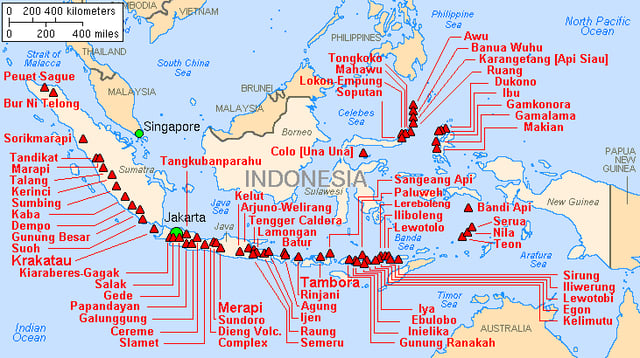
Major volcanoes in Indonesia.
Tectonically, Indonesia is highly unstable, making it a site of numerous volcanoes and frequent earthquakes.[94] It lies on the Pacific Ring of Fire where the Indo-Australian Plate and the Pacific Plate are pushed under the Eurasian plate where they melt at about 100 kilometres (62 miles) deep. A string of volcanoes runs through Sumatra, Java, Bali and Nusa Tenggara, and then to the Banda Islands of Maluku to northeastern Sulawesi.[95] Of the 400 volcanoes, around 130 are active.[96] Between 1972 and 1991, there were 29 volcanic eruptions, mostly on Java.[97] Volcanic ash has made agricultural conditions unpredictable in some areas.[98] However, it has also resulted in fertile soils, a factor in historically sustaining high population densities of Java and Bali.[99]
A massive supervolcano erupted at present-day Lake Toba around 70,000 BCE. It is believed to have caused a global volcanic winter and cooling of the climate, and subsequently led to a genetic bottleneck in human evolution, though this is still in debate.[100] The 1815 eruption of Mount Tambora and the 1883 eruption of Krakatoa were among the largest in recorded history. The former caused 92,000 deaths and created an umbrella of volcanic ash which spread and blanketed parts of the archipelago, and made much of Northern Hemisphere without summer in 1816.[101] The latter produced the loudest sound in recorded history and caused 36,000 deaths due to the eruption itself and the resulting tsunamis. There were significant additional effects around the world years after the event.[102] Recent catasthropic disasters due to seismic activity include the 2004 Indian Ocean earthquake and the 2006 Yogyakarta earthquake.
Biodiversity
Indonesia's size, tropical climate, and archipelagic geography support a high level of biodiversity.[18] Its flora and fauna is a mixture of Asian and Australasian species.[103] The islands of the Sunda Shelf (Sumatra, Java, Borneo, and Bali) were once linked to mainland Asia, and have a wealth of Asian fauna. Large species such as the Sumatran tiger, rhinoceros, orangutan, Asian elephant, and leopard were once abundant as far east as Bali, but numbers and distribution have dwindled drastically. Having been long separated from the continental landmasses, Sulawesi, Nusa Tenggara, and Maluku have developed their unique flora and fauna.[104] Papua was part of the Australian landmass and is home to a unique fauna and flora closely related to that of Australia, including over 600 bird species.[105] Forests cover approximately 70% of the country.[106] However, the forests of the smaller, and more densely populated Java, have largely been removed for human habitation and agriculture.
Indonesia is second only to Australia in terms of total endemic species, with 36% of its 1,531 species of bird and 39% of its 515 species of mammal being endemic.[107] Tropical seas surround Indonesia's 80,000 kilometres (50,000 miles) of coastline.
The country has a range of sea and coastal ecosystems, including beaches, dunes, estuaries, mangroves, coral reefs, seagrass beds, coastal mudflats, tidal flats, algal beds, and small island ecosystems.[24] Indonesia is one of Coral Triangle countries with the world's most enormous diversity of coral reef fish with more than 1,650 species in eastern Indonesia only.[108]
British naturalist Alfred Russel Wallace described a dividing line (Wallace Line) between the distribution of Indonesia's Asian and Australasian species.[109] It runs roughly north-south along the edge of the Sunda Shelf, between Kalimantan and Sulawesi, and along the deep Lombok Strait, between Lombok and Bali. Flora and fauna on the west of the line are generally Asian, while east from Lombok they are increasingly Australian until the tipping point at the Weber Line. In his 1869 book, The Malay Archipelago, Wallace described numerous species unique to the area.[110]*The%20Malay%20Archipelag]]The%20Malay%20Archipelag]]
Environment

Deforestation in Riau province, Sumatra, to make way for an oil palm plantation
Indonesia's large and growing population and rapid industrialisation present serious environmental issues. They are often given a lower priority due to high poverty levels and weak, under-resourced governance.[111] Problems include the destruction of peatlands, large-scale illegal deforestation—and the resulting Southeast Asian haze—over-exploitation of marine resources, air pollution, garbage management, and reliable water and wastewater services.[111] These issues contribute to Indonesia's poor ranking (#133 out of 180 countries) in the 2018 Environmental Performance Index. The report also indicates that Indonesia's performance is among the lowest in the Asia-Pacific region.[112]
Expansion of the palm oil industry requiring significant changes to the natural ecosystems is the one primary factor behind much of Indonesia's deforestation.[113] While it can generate wealth for local communities, it may degrade ecosystems and cause social problems.[114] This situation makes Indonesia the world's largest forest-based emitter of greenhouse gases.[115] It also threatens the survival of indigenous and endemic species. The International Union for Conservation of Nature (IUCN) identified 140 species of mammals as threatened, and 15 as critically endangered, including the Bali starling,[116] Sumatran orangutan,[117] and Javan rhinoceros.[118]
Several studies consider Indonesia to be at severe risk from the projected effects of climate change.[119] They predict that unreduced emissions will see an average temperature rise of around 1℃ by mid-century,[120][121] amounting to almost double the frequency of scorching days (above 35℃) per year by 2030. That figure is predicted to rise further by the end of the century.[120] It will raise the frequency of drought and food shortages, having an impact on precipitation and the patterns of wet and dry seasons, the basis of Indonesia's agricultural system.[121] It will also encourage diseases and increases in wildfires, which threaten the country's enormous rainforest.[121] Rising sea levels, at current rates, will result in 42 million households in over 2,000 islands being at risk of submersion by mid-century.[122] A majority of Indonesia's population lives in low-lying coastal areas,[121] including the capital Jakarta, the fastest sinking city in the world.[123] Impoverished communities will likely be affected the most by climate change.[124]
Government and politics
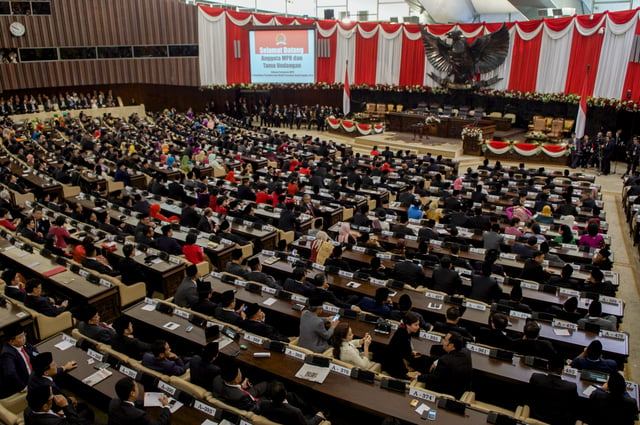
A presidential inauguration by the MPR in the Parliament Complex Jakarta, 2014
Indonesia is a republic with a presidential system.
Following the fall of the New Order in 1998, political and governmental structures have undergone sweeping reforms, with four constitutional amendments revamping the executive, legislative and judicial branches.[125] Chief among them is the delegation of power and authority to various regional entities while remaining a unitary state.[126] The President of Indonesia is the head of state and head of government, commander-in-chief of the Indonesian National Armed Forces (Tentara Nasional Indonesia, TNI), and the director of domestic governance, policy-making, and foreign affairs. The president may serve a maximum of two consecutive five-year terms.[127]
The highest representative body at the national level is the People's Consultative Assembly (Majelis Permusyawaratan Rakyat, MPR). Its main functions are supporting and amending the constitution, inaugurating and impeaching the president,[128][129] and formalising broad outlines of state policy. The MPR comprises two houses; the People's Representative Council (Dewan Perwakilan Rakyat, DPR), with 575 members, and the Regional Representative Council (Dewan Perwakilan Daerah, DPD), with 136.[130] The DPR passes legislation and monitors the executive branch. Reforms since 1998 have markedly increased its role in national governance,[125] while the DPD is a new chamber for matters of regional management.[131][129]
Most civil disputes appear before the State Court (Pengadilan Negeri); appeals are heard before the High Court (Pengadilan Tinggi). The Supreme Court of Indonesia (Mahkamah Agung) is the country's highest court, and hears final cessation appeals and conducts case reviews. Other courts include the Commercial Court, which handles bankruptcy and insolvency; the State Administrative Court (Pengadilan Tata Negara) to hear administrative law cases against the government; the Constitutional Court (Mahkamah Konstitusi) to listen to disputes concerning legality of law, general elections, dissolution of political parties, and the scope of authority of state institutions; and the Religious Court (Pengadilan Agama) to deal with codified Islamic Law (sharia) cases.[132] Additionally, the Judicial Commission (Komisi Yudisial) monitors the performance of judges.
Parties and elections
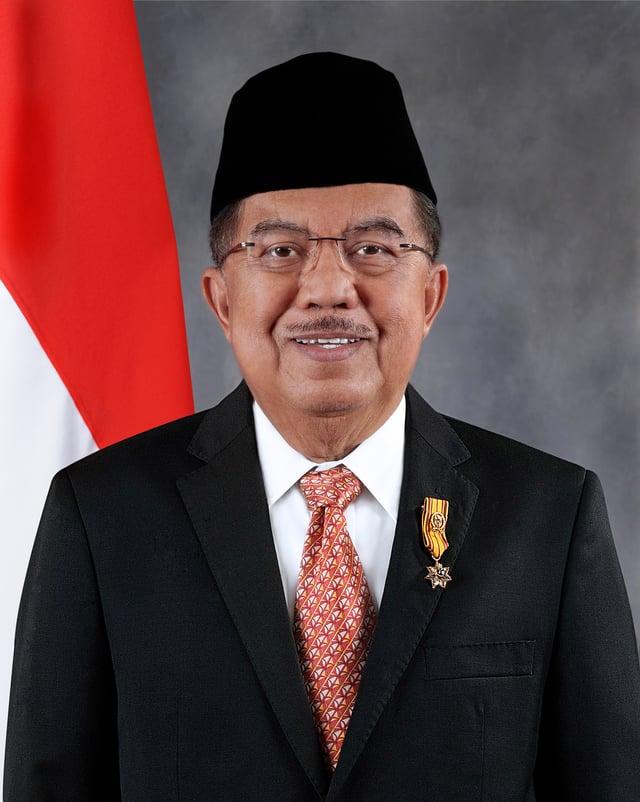
Jusuf Kalla 10th and 12th Vice President of Indonesia

Joko Widodo 7th President of Indonesia
Since 1999, Indonesia has had a multi-party system.
In all legislative elections since the fall of the New Order, no political party has managed to win an overall majority of seats. The Indonesian Democratic Party of Struggle (PDI-P), which secured the most votes in the 2014 elections, is the party of the current President, Joko Widodo.[133] The Great Indonesia Movement Party (Gerindra) is the third-largest political party.[134] Other notable parties include the Party of the Functional Groups (Golkar), the Democratic Party, and the National Awakening Party (PKB). Based on the 2014 elections, the DPR consists of ten political parties, with a parliamentary threshold of 3.5% of the national vote.[135] The first general election was held in 1955 to elect members of the DPR and the Constitutional Assembly (Konstituante). At the national level, Indonesians did not elect a president until 2004. Since then, the president is elected for a five-year term, as are the party-aligned members of the DPR and the non-partisan DPD.[130][125] Beginning with 2015 local elections, elections for governors and mayors have occurred on the same date. As of 2019, both legislative and presidential elections coincide.
Administrative divisions
Indonesia has several levels of subdivisions.
The first level is the provinces, five out of a total of 34 have special status.
Each has a legislature (Dewan Perwakilan Rakyat Daerah, DPRD) and an elected governor. The second is the regencies (kabupaten) and cities (kota), led by regents (bupati) and mayors (walikota) respectively and a legislature (DPRD Kabupaten/Kota). The third is the districts (kecamatan or distrik in Papua), and finally the fourth is the administrative villages (either desa, kelurahan, kampung, nagari in West Sumatra, or gampong in Aceh). This number has evolved, with the most recent change being the split of North Kalimantan from East Kalimantan in 2012.[136]
The village is the lowest level of government administration.
It is divided into several community groups (rukun warga, RW), which are further divided into neighbourhood groups (rukun tetangga, RT). In Java, the village (desa) is divided into smaller units called dusun or dukuh (hamlets), which are the same as RW. Following the implementation of regional autonomy measures in 2001, regencies and cities have become chief administrative units, responsible for providing most government services. The village administration level is the most influential on a citizen's daily life and handles matters of a village or neighbourhood through an elected village chief (lurah or kepala desa).
Aceh, Jakarta, Yogyakarta, Papua, and West Papua have greater legislative privileges and a higher degree of autonomy from the central government than the other provinces. Aceh has the right to create some aspects of an independent legal system, and several regional parties participate only in elections held there.[137] In 2003, it instituted a form of sharia.[138] Yogyakarta was granted the status of Special Region in recognition of its pivotal role in supporting the Republicans during the National Revolution and its willingness to join Indonesia as a republic.[139] Papua, formerly known as Irian Jaya, was granted special autonomy status in 2001 and was split into Papua and West Papua in 2003.[140] Jakarta is the country's Special Capital Region (Daerah Khusus Ibukota, DKI).
Foreign relations
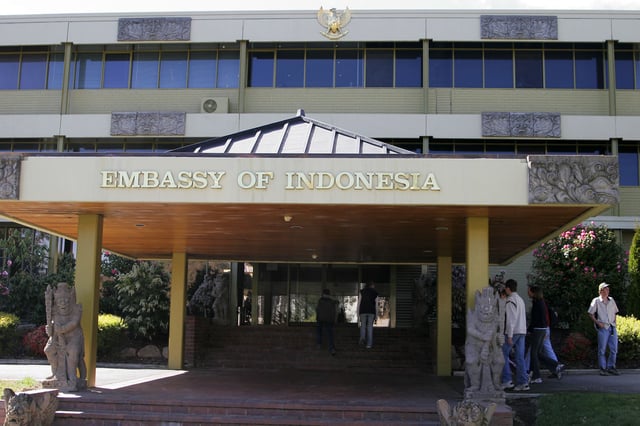
Embassy of Indonesia, Canberra, Australia
Indonesia maintains 132 diplomatic missions abroad, including 95 embassies[141] The country adheres to what it calls a "free and active" foreign policy, seeking a role in regional affairs in proportion to its size and location but avoiding involvement in conflicts among other countries.[142] Indonesia was a significant battleground during the Cold War. Numerous attempts by the United States and the Soviet Union,[143][144] and China to some degree,[145] culminated in the 1965 coup attempt and subsequent upheaval that led to a reorientation of foreign policy. Quiet alignment with the West while maintaining a non-aligned stance has characterised Indonesia's foreign policy since then.[146] Today, it maintains close relations with its neighbours and is a founding member of ASEAN and the East Asia Summit. In common with most of the Muslim world, Indonesia does not have diplomatic relations with Israel and has actively supported Palestine. However, observers have pointed out that Indonesia has ties with Israel, albeit discreetly.[147]
Indonesia has been a member of the United Nations since 1950 and was a founding member of the Non-Aligned Movement (NAM) and the Organisation of Islamic Cooperation (OIC).[148] Indonesia is a signatory to the ASEAN Free Trade Area agreement, the Cairns Group, and the World Trade Organization (WTO), and an occasional member of OPEC.[149] During the Indonesia–Malaysia confrontation, Indonesia withdrew from the UN due to the latter's election to the United Nations Security Council, although it returned 18 months later. It marked the first time in UN history that a member state had attempted a withdrawal.[150] Indonesia has been a humanitarian and development aid recipient since 1966,[151][152][153] and recently, the country has expressed interest in becoming an aid donor.[154]
Military
Indonesia's Armed Forces (TNI) include the Army (TNI–AD), Navy (TNI–AL, which includes Marine Corps), and Air Force (TNI–AU).[155] The army has about 400,000 active-duty personnel. Defence spending in the national budget was 0.8% of GDP in 2017,[156] with controversial involvement of military-owned commercial interests and foundations.[157] The Armed Forces were formed during the Indonesian National Revolution when it undertook guerrilla warfare along with informal militia. Since then, territorial lines have formed the basis of all TNI branches' structure, aimed at maintaining domestic stability and deterring foreign threats.[158] The military has possessed a strong political influence since its founding, reaching its greatest extent during the New Order. Political reforms in 1998 included the removal of the TNI's formal representation from the legislature. Nevertheless, its political influence remains, albeit at a reduced level.[159]
Since independence, the country has struggled to maintain unity against local insurgencies and separatist movements.[160] Some, notably in Aceh and Papua, have led to an armed conflict, and subsequent allegations of human rights abuses and brutality from all sides.[161][162] The former was resolved peacefully in 2005,[84] while the latter continues, amid a significant, albeit imperfect, implementation of regional autonomy laws, and a reported decline in the levels of violence and human rights abuses since 2004.[163] Other engagements of the army include the campaign against the Netherlands New Guinea to incorporate the territory into Indonesia, the Konfrontasi to oppose the creation of Malaysia, the mass killings of PKI, and the invasion of East Timor, which remains Indonesia's most massive military operation.[164][165]
Economy
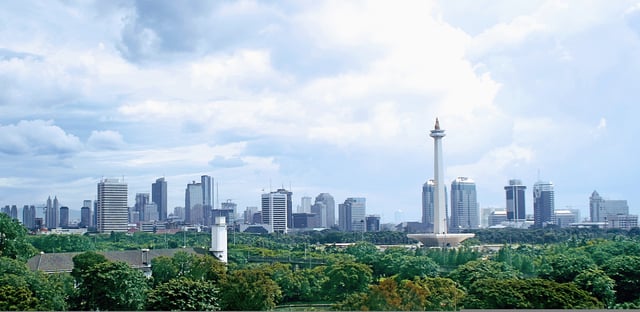
Jakarta, the capital city and the country's commercial centre
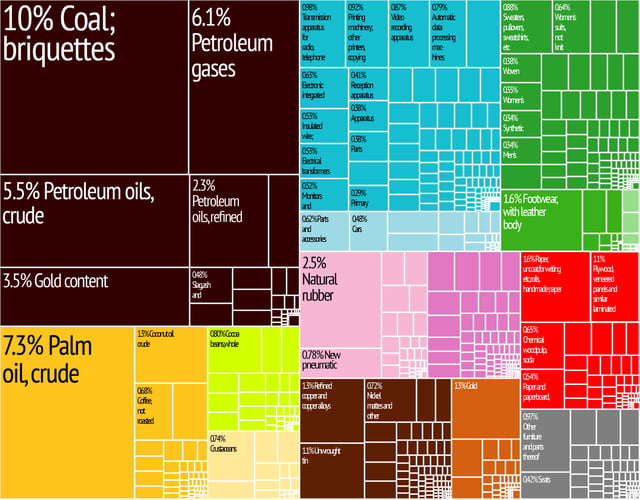
A proportional representation of Indonesia's exports (2012)
Indonesia has a mixed economy in which both the private sector and government play vital roles.[166] The country has the largest economy in Southeast Asia, is a member of the G20,[167] and is classified as a newly industrialised country. As of 2018, it is the world's 16th largest economy by nominal GDP and 7th in terms of GDP at PPP, estimated to be US$1.074 trillion and US$3.481 trillion respectively. Per capita GDP in PPP is US$13,120, while nominal per capita GDP is US$4,116.[11] The debt ratio to GDP is 29.2%.[168] The services are the economy's largest sector and account for 43.6% of GDP (2017), followed by industry (39.3%) and agriculture (13.1%).[169] Since 2009, it has employed more people than other sectors, accounting for 47.1% of the total labour force, followed by agriculture (31.1%) and industry (21.7%).[170]
Over time, the structure of the economy has changed considerably.[171] Historically, it has been heavily weighted towards agriculture, reflecting both its stage of economic development and government policies in the 1950s and 1960s to promote agricultural self-sufficiency.[171] A gradual process of industrialisation and urbanisation began in the late 1960s and accelerated in the 1980s as falling oil prices saw the government focus on diversifying away from oil exports and towards manufactured exports.[171] This development continued throughout the 1980s and into the next decade despite the 1990 oil price shock, during which the GDP rose at an average rate of 7.1%. As a result, the official poverty rate fell from 60% to 15%.[172] Reduction of trade barriers from the mid-1980s made the economy more globally integrated. The growth, however, ended with the 1997 Asian financial crisis, which severely affected Indonesia both economically and politically. It caused a real GDP contraction by 13.1% in 1998, and inflation reached 72%. The economy reached its low point in mid-1999 with only 0.8% real GDP growth.
Relatively steady inflation[173] and an increase in GDP deflator and Consumer Price Index[174] contribute to strong economic growth in recent years. Since 2007, with improvement in the banking sector and domestic consumption, growth has accelerated to between 4% and 6% annually.[175] This helped Indonesia weather the 2008–2009 Great Recession,[176] during which the economy performed strongly. In 2011, the country regained the investment grade rating it had lost in 1997.[177] As of 2017, 10.12% of the population lived below the poverty line, and the official open unemployment rate was 4.3%.[178][179]
Though Indonesia ran a trade surplus from 1975 to 2017, exports and imports during the last few years have decreased at an annual rate of 3 to 4.8%, from US$224 billion and US$173 billion, respectively in 2011.
In 2018, the country recorded a trade deficit of US$8.57 billion, with a total export value of $180.06 billion, and import $188.6 billion.[180] Palm oil and coal briquettes are the main exports, with petroleum gas, crude petroleum, rubber and cars making up the majority of other exports.
Imports mostly consist of refined and crude petroleum, with telephones, petroleum gas, vehicle parts and wheat covering the majority of additional imports.
China, the United States, Japan, Singapore, India, Malaysia, South Korea and Thailand are Indonesia's principal export market and import partners.[19]
Transport
Indonesia's transport system has been shaped over time by the economic resource base of an archipelago, and the distribution of its 250 million people highly concentrated on Java.[181] All transport modes play a role in the country's transport system and are generally complementary rather than competitive. In 2016, the transport sector generated about 5.2% of GDP.[182]
The road transport system is predominant, with a total length of 539,353 kilometres (335,138 miles) as of 2017.[183] Jakarta has the most extended bus rapid transit system in the world, boasting some 251.2 kilometres (156.1 miles) in 13 corridors and ten cross-corridor routes.[184] Rickshaws such as bajaj and becak, and share taxis such as Angkot and Metromini are a regular sight in the country. Most of the railways are in Java, used for both freight and passenger transport, such as local commuter rail services complementing the inter-city rail network in several cities. During the last few years, construction is underway for mass rapid transit and light rail transit systems in Jakarta and Palembang.[185][186] In 2015, the government announced a plan to build a high-speed rail, which would be a first in Southeast Asia.[187]
Indonesia's largest airport, Soekarno–Hatta International Airport is the busiest in the Southern Hemisphere, serving 63 million passengers in 2017.[188] Ngurah Rai International Airport and Juanda International Airport are the country's second- and third-busiest airport respectively. Garuda Indonesia, the country's flag carrier since 1949, is one of the world's leading airlines and a member of the global airline alliance SkyTeam. Port of Tanjung Priok is the busiest and most advanced Indonesian port,[189] handling more than 50% of Indonesia's trans-shipment cargo traffic.
Energy
In 2016, Indonesia was the world's 9th largest energy producer with 16.8 quadrillions BTU, and the 15th largest energy consumer, with 7.5 quadrillions BTU.[190] The country has substantial energy resources, including 22 billion barrels of conventional oil and gas reserves (of which about 4 billion are recoverable), 8 billion barrels of oil-equivalent of coal-based methane (CBM) resources, and 28 billion tonnes of recoverable coal.[191] While reliance on domestic coal and imported oil have increased,[192] Indonesia has seen progress in renewable energy with hydropower being the most abundant source. Furthermore, the country has the potential for geothermal, solar, wind, biomass and ocean energy.[193] Indonesia has set out to achieve 23% use of renewable energy by 2025 and 31% by 2050.[192] As of 2015, Indonesia's total national installed power generation capacity stands at 55,528.51 MW.[194]
The country's largest dam, Jatiluhur, has several purposes including the provision of hydroelectric power generation, water supply, flood control, irrigation and aquaculture. The earth-fill dam is 105 m (344 ft) high and withholds a reservoir of 3,000,000,000 m3 (2,432,140 acre⋅ft). It helps to supply water to Jakarta and to irrigate 240,000 ha (593,053 acres) of rice fields[195] and has an installed capacity of 186.5 MW which feeds into the Java grid managed by the State Electricity Company (Perusahaan Listrik Negara
Science and technology
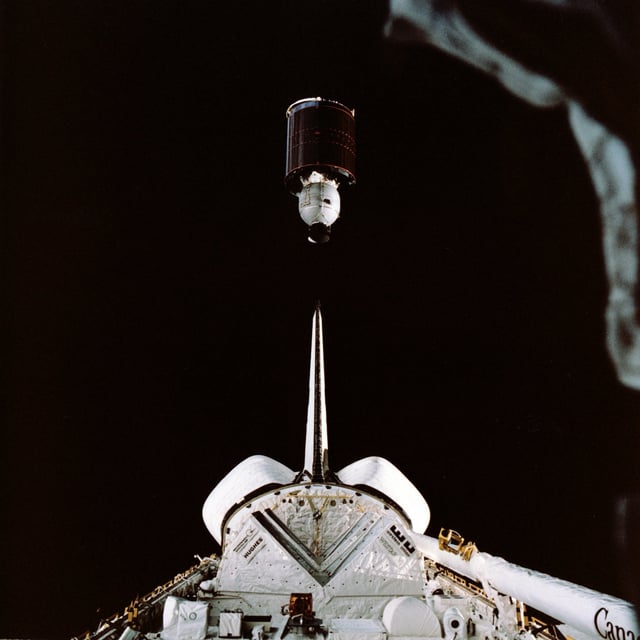
Palapa satellite launch in 1984
Indonesia's expenditure on science and technology is relatively low, at less than 0.1% of GDP (2017).[196] Historical examples of scientific and technological developments include the paddy cultivation technique terasering, which is common in Southeast Asia, and the pinisi boats by the Bugis and Makassar people.[197] In the 1980s, Indonesian engineer Tjokorda Raka Sukawati invented a road construction technique named Sosrobahu that allows construction of long stretches of flyovers above existing main roads with minimum traffic disruption. It later became widely used in several countries.[198] The country is also an active producer of passenger trains and freight wagons with its state-owned company, the Indonesian Railway Industry (INKA), and has exported trains abroad.[199]
Indonesia has a long history in developing military and small commuter aircraft as the only country in Southeast Asia to build and produce aircraft.
With its state-owned company, the Indonesian Aerospace (PT. Dirgantara Indonesia), Indonesia has provided components for Boeing and Airbus. The company also collaborated with EADS CASA of Spain to develop the CN-235 that has seen use by several countries.[200] Former President B. J. Habibie played a vital role in this achievement.[201] Indonesia has also joined the South Korean programme to manufacture the fifth-generation jet fighter KAI KF-X.[202]
Indonesia has a space programme and space agency, the National Institute of Aeronautics and Space (Lembaga Penerbangan dan Antariksa Nasional, LAPAN). In the 1970s, Indonesia became the first developing country to operate a satellite system called Palapa,[203] a series of communication satellites owned by Indosat Ooredoo. The first satellite, PALAPA A1 was launched on 8 July 1976 from the Kennedy Space Center in Florida, United States.[204] As of 2017, Indonesia has launched 16 satellites for various purposes,[205] and LAPAN has expressed a desire to put satellites in orbit with native launch vehicles by 2040.[206]
Tourism
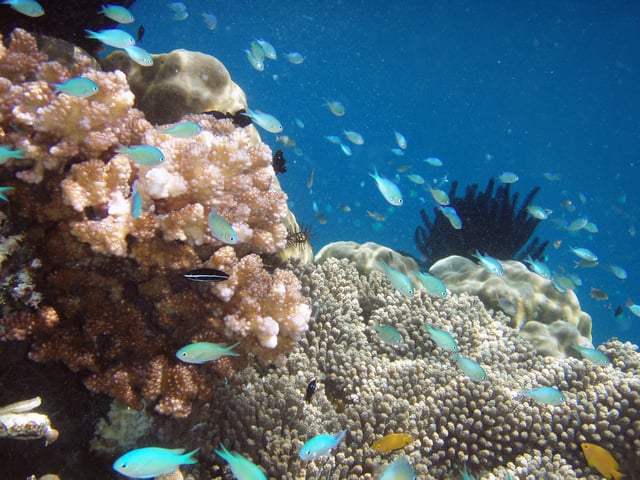
According to Conservation International, Raja Ampat Islands has the highest recorded level of diversity in marine life[207]
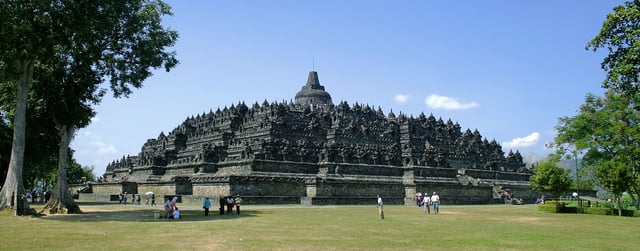
Borobudur in Java, the world's largest Buddhist temple, is the single most visited tourist attraction in Indonesia[211]
Tourism contributed around US$28.2 billion to GDP in 2017.[208] In the same year, Indonesia received 14.04 million visitors, a growth of 21.8% in one year,[209] spending an average of US$2,009 per person during their visit. China, Singapore, Malaysia, Australia, and Japan are the top five sources of visitors to Indonesia. Since 2011, Wonderful Indonesia has been the slogan of the country's international marketing campaign to promote tourism.[210]
Nature and culture are prime attractions of Indonesian tourism.
The former can boast a unique combination of a tropical climate, a vast archipelago, and a long stretch of beaches, and the latter complement those with a rich cultural heritage reflecting Indonesia's dynamic history and ethnic diversity.
Indonesia has a well-preserved natural ecosystem with rain forests that stretch over about 57% of Indonesia's land (225 million acres).
Forests on Sumatra and Kalimantan are examples of popular destinations, such as the Orangutan wildlife reserve.
Moreover, Indonesia has one of the world's longest coastlines, measuring 54,716 kilometres (33,999 mi). The ancient Prambanan and Borobudur temples, Toraja and Bali, with its Hindu festivities, are some of the popular destinations for cultural tourism.
Indonesia has 8 UNESCO World Heritage Sites, including the Borobudur Temple Compounds and the Komodo National Park; and a further 19 in a tentative list that includes the Jakarta Old Town, Bunaken National Park, and Raja Ampat Islands.[212] Other attractions include the specific points in Indonesian history, such as the colonial heritage of the Dutch East Indies, the Jakarta Old Town and the Javanese royal courts of Yogyakarta, Surakarta and Mangkunegaran.
The 2017 Travel and Tourism Competitiveness Report ranks Indonesia 42nd out of 136 countries overall with a score of 4.2.[208] It lists the price competitiveness of Indonesia's tourism sector the fifth out of 136 countries. The report states that Indonesia scores well on visa policy (#2) and international openness (#17), as well as on natural (#17) and cultural resources (#23). However, Indonesia has a low score in infrastructure (#96), as some aspects of tourist service infrastructure are underdeveloped.[208]
Demographics
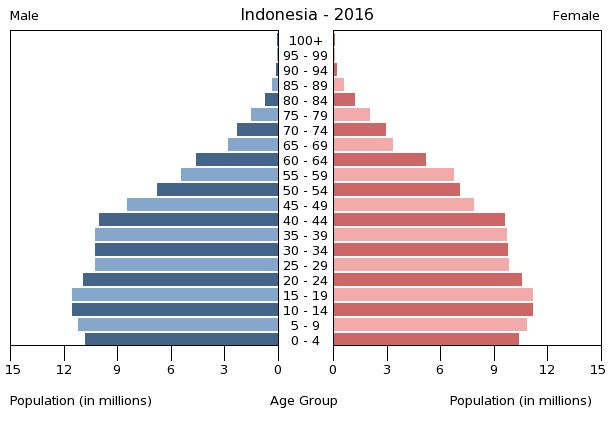
Population pyramid 2016
The 2010 census recorded Indonesia's population as 237.6 million, with high population growth at 1.9%.[213] 58% of the population lives in Java,[214] the world's most populous island.[17] The population density is 138 people per km2 (357 per sq mi), ranking 88th in the world,[215] although Java has a population density of 1,067 people per km2 (2,435 per sq mi). The spread of the population is uneven throughout the islands with a varying habitat and level of development, ranging from the megalopolis of Jakarta to uncontacted tribes in Papua.[216] In 1961, the first post-colonial census recorded a total of 97 million people.[217] It is expected to grow to around 295 million by 2030 and 321 million by 2050.[218] The country currently possesses a relatively young population, with a median age of 30.2 years (2017 estimate).[89] About 8 million Indonesians live overseas; most settled in Malaysia, Netherlands, Saudi Arabia, United Arab Emirates, Hong Kong, Singapore, the United States, and Australia.[219]
Ethnicity and language

A map of ethnic groups in Indonesia
Indonesia is an ethnically diverse country, with around 300 distinct native ethnic groups.[220] Most Indonesians descend from Austronesian-speaking peoples whose languages had origins in Proto-Austronesian, which possibly originated in what is now Taiwan. Another major grouping is the Melanesians, who inhabit eastern Indonesia (the Maluku Islands and Western New Guinea).[35][221][222] The Javanese are the largest ethnic group, comprising 40.2% of the population. They are predominantly located in the central to eastern parts of Java and also sizable numbers in most provinces. The Sundanese, Batak, and Madurese are the largest non-Javanese groups.[3] A sense of Indonesian nationhood exists alongside strong regional identities.[223]
The country's official language is Indonesian, a variant of Malay based on its prestige dialect, which for centuries had been the lingua franca of the archipelago. It was promoted by nationalists in the 1920s and achieved official status under the name Bahasa Indonesia in 1945.[224] As a result of centuries-long contact with other languages, it is rich in local and foreign influences, including from Javanese, Sundanese, Minangkabau, Hindi, Sanskrit, Chinese, Arabic, Dutch, Portuguese and English.[225][226][227] Nearly every Indonesian speaks the language due to its widespread use in education, academics, communications, business, politics, and mass media. Most Indonesians also speak at least one of more than 700 local languages,[6] often as their first language. Some belong to the Austronesian language family, while there are over 270 Papuan languages spoken in eastern Indonesia.[6] Of these, Javanese is the most widely spoken.[89]
In 1930, Dutch and other Europeans (Totok), Eurasians, and derivative people like the Indos, numbered 240,000 or 0.4% of the total population.[228] Historically, they constituted only a tiny fraction of the native population and continue to do so today. Despite the Dutch presence for almost 350 years, the Dutch language never had substantial number of speakers or official status.[229] The small minorities that can speak it or Dutch-based creole languages fluently are the aforementioned ethnic groups and descendants of Dutch colonisers. Today, there is some degree of fluency by either educated members of the oldest generation or legal professionals,[230] as specific law codes are still only available in Dutch.[231]
Urban centres
Religion

A Hindu shrine dedicated to Sri Baduga Maharaja in Pura Parahyangan Agung Jagatkarta, Bogor. Hinduism has left a lasting impact in Indonesian art and culture.

Eid al-Fitr mass prayer in Istiqlal Mosque, Jakarta
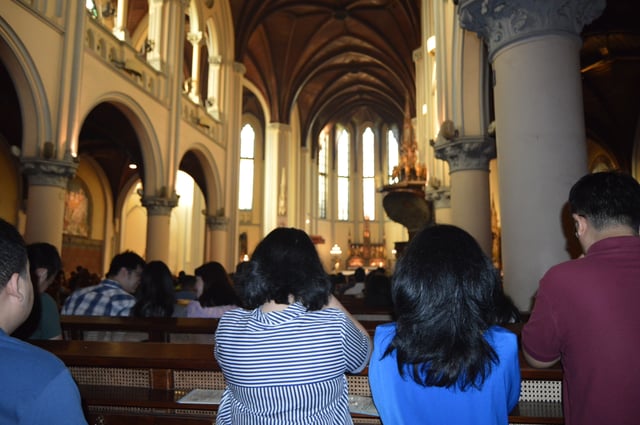
Catholic Mass at the Jakarta Cathedral
While the constitution stipulates religious freedom,[232][129] the government officially recognises only six religions: Islam, Protestantism, Roman Catholicism, Hinduism, Buddhism, and Confucianism;[233][234] with indigenous religions only partly acknowledged.[234] Indonesia is the world's most populous Muslim-majority country[16] with 227 million adherents in 2017, with the majority being Sunnis (99%).[235] The Shias and Ahmadis respectively constitute 1% (1–3 million) and 0.2% (200,000–400,000) of the Muslim population.[234][236] Almost 10% of Indonesians are Christians, while the rest are Hindus, Buddhist, and others. Most Hindus are Balinese,[237] and most Buddhists are ethnic Chinese.[238] An overwhelming majority of Indonesians consider religion to be essential,[239] and its role is present in almost all aspects of society, including politics, education, marriage,[240] and public holidays. A majority of national holidays in 2019 is related to religion.[241]
Before the arrival of Hinduism, Buddhism and Abrahamic religions, the natives of the Indonesian archipelago practised indigenous animism and dynamism, beliefs that are common to Austronesian people.[242]*Southeast%20Asia%3A%20A%20hist]]*hey worshipped and revered ancestral spirit, and believed that supernatural spirits ([242]Sundanese Sunda Wiwitan Dayak Kaharingan Torajan Manusela Nuaulu Naurus, Batak's Parmalim and Pemena, and the Javanese Kejawèn. They have had a significant impact on how other faiths are practised, evidenced by a large proportion of people—such as the Javanese abangan, Balinese Hindus, and Dayak Christians—practising a less orthodox, syncretic form of their religion.[243]
Hindu influences reached the archipelago as early as the first century CE.[244] Around 130, a Sundanese kingdom named Salakanagara emerged in western Java. It was the first historically recorded Indianised kingdom in the archipelago, created by an Indian trader following marriage to a local Sundanese princess.[245] Buddhism arrived around the 6th century,[246] and its history in Indonesia is closely related to that of Hinduism, as some empires based on Buddhist culture had its roots around the same period. The archipelago has witnessed the rise and fall of powerful and influential Hindu and Buddhist empires such as Majapahit, Sailendra, Srivijaya, and Mataram. Though no longer a majority, Hinduism and Buddhism remain defining influences in Indonesian culture.
Islam was introduced to the archipelago by Sunni traders of the Shafi'i fiqh, as well as Sufi traders from the Indian subcontinent and southern Arabian peninsula.[247] Missionary works such as by the Wali Sanga and Chinese explorer Zheng He, and military campaigns by several sultanates helped accelerate the spread of the religion.[248][249] For the most part, Islam overlaid and mixed with existing cultural and religious influences that resulted in a distinct form of Islam,[45] particularly in comparison to the Middle East.[250] Trends of thought within Islam in the country fall broadly under two orientations; "modernism" which closely adheres to orthodoxy while embracing modern learning, and "traditionalism" which tends to follow the interpretations of local religious leaders and teachers at Islamic boarding schools (pesantren). They are supported by Indonesia's two largest Islamic civil society groups Muhammadiyah and Nahdlatul Ulama, respectively.
Catholicism was brought to the archipelago by Portuguese traders and missionaries such as Jesuit Francis Xavier, who visited and baptised several thousand locals.[251][252] Its spread faced difficulty due to the VOC policy of banning the religion and the Dutch hostility due to the Eighty Years' War against Catholic Spain's rule. In present-day Flores, the royal house of Larantuka formed the only native Catholic kingdom in Southeast Asia around the 16th century, with the first king named Lorenzo.[253] Protestantism is mostly a result of Calvinist and Lutheran missionary efforts during the Dutch colonial era.[254][255][256] Although they are the most common branch, there is a multitude of other denominations elsewhere in Indonesia.[257] The Batak Protestant Christian Church, founded in 1861 by German Lutheran missionary Ludwig Ingwer Nommensen, is the largest one.[258]
Education and health

Bandung Institute of Technology in West Java
Education in Indonesia is compulsory for 12 years.[259] Parents can choose between state-run, non-sectarian schools or private or semi-private religious (usually Islamic) schools, supervised by the ministries of Education and Religion, respectively.[260] Private international schools that do not follow the national curriculum are also available. The enrolment rate is 90% for primary education, 76% for secondary education, and 24% for tertiary education (2015). The literacy rate is 95% (2016), and the government spends about 3.6% of GDP (2015) on education.[261] In 2018, there were more than 4,500 higher educational institutions in Indonesia.[262] The top universities are the Java-based University of Indonesia, Bandung Institute of Technology and Gadjah Mada University.[262] Andalas University is pioneering the establishment of a leading university outside of Java.[263]
Government expenditure on healthcare is about 3.3% of GDP in 2016.[264] As part of an attempt to achieve universal health care, the government launched the National Health Insurance (Jaminan Kesehatan Nasional, JKN) in 2014 that gives protections to citizens.[265] They include coverage for a range of health services from the public and also private firms that have opted to join the scheme. In recent decades, there have been remarkable improvements such as rising life expectancy (from 63 in 1990 to 71 in 2012) and declining child mortality (from 84 deaths per 1,000 births in 1990 to 27 deaths in 2015).[266] Nevertheless, Indonesia continues to face challenges that include maternal and child health, low air quality, malnutrition, high rate of smoking, and infectious diseases.[267]
Issues
Nearly 80% of Indonesia's population lives in the western parts of the archipelago,[268] but they are growing at a slower pace than the rest of the country.
This situation creates a gap in wealth, unemployment rate, and health between densely populated islands and economic centres (such as Sumatra and Java) and sparsely populated, disadvantaged areas (such as Maluku and Papua).[269][270] Racism, especially against Chinese Indonesians since the colonial period, is still prevalent today.[271][272] Religious intolerance has long been a feature of the country's society, with the most recent high-profile case being that of Chinese Christian former governor of Jakarta, Basuki Tjahaja Purnama.[273] LGBT issues have recently gained attention in Indonesia.[274] While homosexuality is legal in most parts of the country, it is illegal in Aceh and South Sumatra.[275] LGBT people and activists have regularly faced fierce opposition, intimidation, and discrimination launched even by authorities.[273]
Culture
The cultural history of the Indonesian archipelago spans more than two millennia.
Influences from the Indian subcontinent, mainland China, the Middle East, Europe,[276][277] and the Austronesian peoples have historically shaped the cultural, linguistic and religious make-up of the archipelago. As a result, modern-day Indonesia has a multicultural, multilingual and multi-ethnic society,[6][220] with a complex cultural mixture that differs significantly from the original indigenous cultures. Indonesia currently holds nine items of UNESCO's Intangible Cultural Heritage, including wayang puppet theatre, batik, angklung, and the three genres of traditional Balinese dance.[278]
Art and architecture
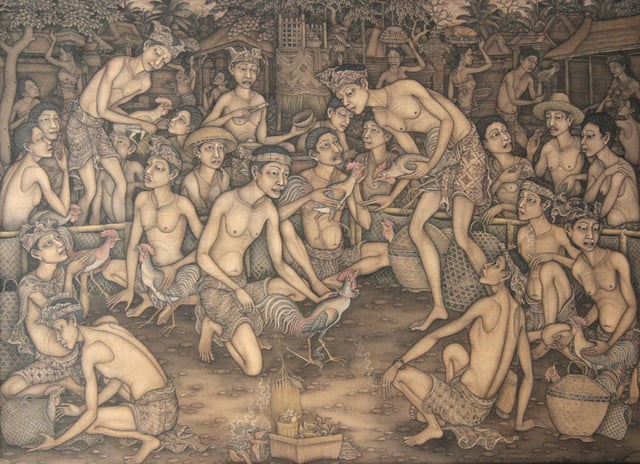
Traditional Balinese painting depicting cockfighting
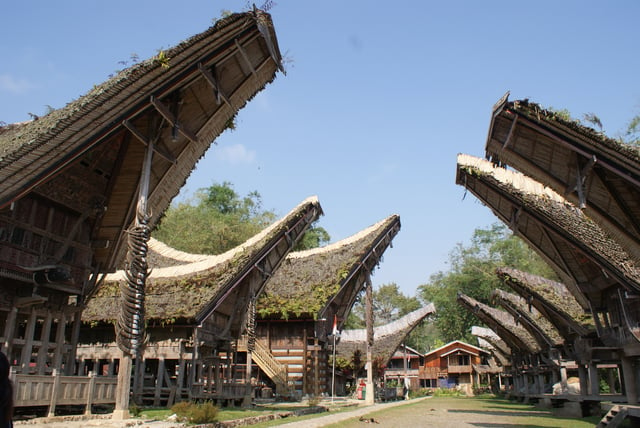
An avenue of Tongkonan houses in a Torajan village
Indonesian arts include both age-old art forms developed through centuries and a recently developed contemporary art. Despite often displaying local ingenuity, Indonesian arts have absorbed foreign influences—most notably from India, the Arab world, China and Europe, as a result of contacts and interactions facilitated, and often motivated, by trade.[279] Painting is an established and developed art in Bali, where its people are famed for their artistry.[280] Their painting tradition started as classical Kamasan or Wayang style visual narrative, derived from visual art discovered on candi bas reliefs in eastern Java.[280] It is notable for its highly vigorous yet refined, intricate art that resembles baroque folk art with tropical themes.[280]
There have been numerous discovery of megalithic sculptures in Indonesia.[281] Subsequently, tribal art has flourished within the culture of Nias, Batak, Asmat, Dayak and Toraja.[282][283] Wood and stone are common materials used as the media for sculpting among these tribes. Between the 8th and 15th centuries, Javanese civilisation has developed a refined stone sculpting art and architecture which was influenced by Hindu-Buddhist Dharmic civilisation. The temples of Borobudur and Prambanan are among the most famous examples of the practice.[284]
As with the arts, Indonesian architecture has absorbed foreign influences that have brought cultural changes and profound effect on building styles and techniques.
The most dominant has traditionally been Indian; however, Chinese, Arab, and European influences have also been significant. Traditional carpentry, masonry, stone and woodwork techniques and decorations have thrived in vernacular architecture, with numbers of traditional houses' (rumah adat) styles that have been developed. The traditional houses and settlements of the numerous ethnic groups of Indonesia vary widely, and each has a specific history. They are at the centre of a web of customs, social relations, traditional laws and religions that bind the villagers together.[285] Examples include Toraja's Tongkonan, Minangkabau's Rumah Gadang and Rangkiang, Javanese style Pendopo pavilion with Joglo style roof, Dayak's longhouses, various Malay houses, Balinese houses and temples, and also different forms of rice barns (lumbung).
Music, dance and clothing
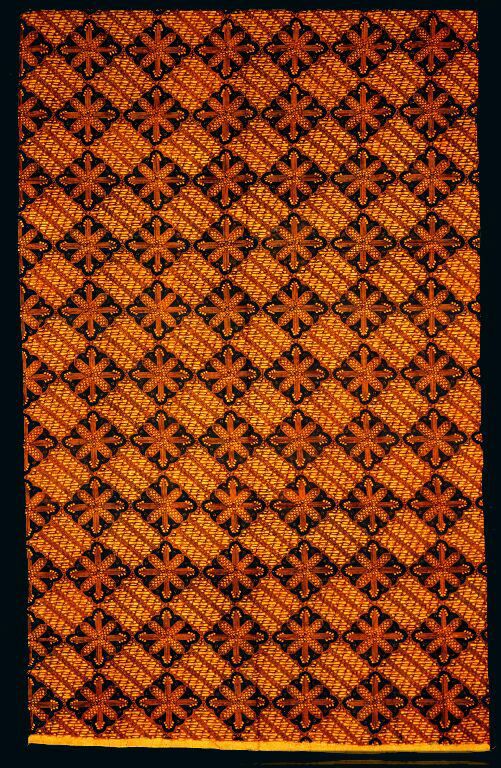
An Indonesian batik
The music of Indonesia predates historical records.
Various indigenous tribes incorporate chants and songs accompanied by musical instruments in their rituals.
Angklung, kacapi suling, siteran, gong, gamelan, degung, gong kebyar, bumbung, talempong, kulintang, and sasando are examples of traditional Indonesian instruments. The diverse world of Indonesian music genres is the result of the musical creativity of its people, and subsequent cultural encounters with foreign influences. These include gambus and qasida from the Middle East,[286] keroncong from Portugal,[287] and dangdut—one of the most popular music genres in Indonesia—with notable Hindi influence as well as Malay orchestras.[288] Today, the Indonesian music industry enjoys both nationwide and regional popularity in Malaysia, Singapore, and Brunei, due to common culture and intelligible languages between Indonesian and Malay.
Indonesian dances have a diverse history, with more than 3,000 original dances.
Scholars believe that they had their beginning in rituals and religious worship.[289] Examples include war dances, a dance of witch doctors, and dance to call for rain or any agricultural rituals such as Hudoq. Indonesian dances derive its influences from the archipelago's three distinct historical eras: the prehistoric and tribal, the Hindu-Buddhist, and the Islamic. In recent times, show businesses, such as those that accompany music performances or entertainment begin showcasing modern dances. Influenced by Western culture, urban teen dances such as street dances have gained popularity among the Indonesian youth. Traditional dances, however, such as the Javanese, Sundanese, Minang, Balinese, Saman continue to be a living and dynamic tradition.
Indonesia has various styles of clothing as a result of its long and rich cultural history.
Its national costume has origins in the indigenous culture of the country and traditional textile traditions.
Since Java is the political, economic and cultural centre of Indonesia, the Javanese Batik and Kebaya[290] are arguably Indonesia's most recognised national costume. They originally belong not only to the Javanese but also to Sundanese and Balinese cultures as well.[291] Each province has a representation of traditional attire and dress,[276] such as Ulos of Batak from North Sumatra; Songket of Malay and Minangkabau from Sumatra; and Ikat of Sasak from Lombok. People wear national and regional costumes during traditional weddings, formal ceremonies, music performances, government and official occasions,[291] and they vary from traditional to modern attire. In 2009, Batik was recognised by UNESCO as a Masterpiece of Oral and Intangible Heritage of Humanity.[292]
Theatre and cinema

Pandava and Krishna in an act of the Wayang Wong performance
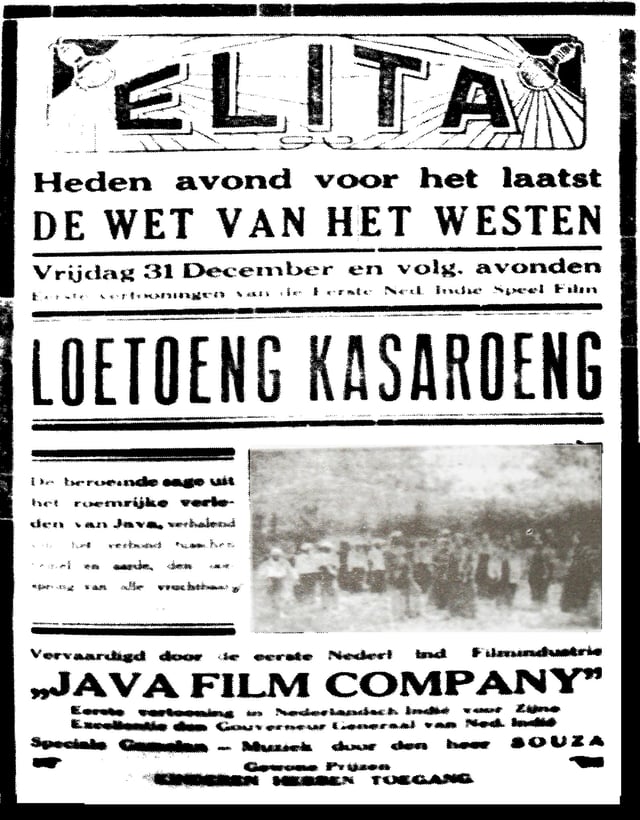
Advertisement for Loetoeng Kasaroeng
Wayang, the Javanese, Sundanese, and Balinese shadow puppet theatre display several mythological legends such as Ramayana and Mahabharata.[293] Other forms of local drama include the Javanese Ludruk and Ketoprak, the Sundanese Sandiwara, Betawi Lenong,[294][295] and various Balinese dance drama. They incorporate humour and jest and often involve audiences in their performances.[296] Some theatre traditions also include music, dancing and the silat martial art such as Randai from Minangkabau people of West Sumatra. It is usually performed for traditional ceremonies and festivals,[297][298] and based on semi-historical Minangkabau legends and love story.[298] Modern performing art also developed in Indonesia with their distinct style of drama. Notable theatre, dance, and drama troupe such as Teater Koma are famous as it often portrays social and political satire of Indonesian society.[299]
The first film produced in the archipelago was Loetoeng Kasaroeng, a silent film by Dutch director L. Heuveldorp. This adaptation of the Sundanese legend was made with local actors by the NV Java Film Company in Bandung. The film industry expanded after independence, with six films made in 1949 rising to 58 in 1955. Djamaluddin Malik's Persari Film often emulated American genre films and the working practices of the Hollywood studio system, as well as remaking popular Indian films.[300] The latter part of the Sukarno era saw the use of cinema for nationalistic, anti-Western purposes, and foreign films were subsequently banned, while the New Order utilised a censorship code that aimed to maintain social order.[301] The film industry's popularity peaked in the 1980s and dominated cinemas,[302] although it declined significantly in the early 1990s.[303] Films made during this period include Pintar-pintar Bodoh (1982), Maju Kena Mundur Kena (1984), Nagabonar (1987), Catatan Si Boy (1989), and Warkop's comedy films. Deddy Mizwar, Eva Arnaz, Meriam Bellina, and Rano Karno were among the well-known actors during this period.
Independent filmmaking was a rebirth of the film industry in the post-Suharto era, where films started addressing previously banned topics, such as religion, race, and love.[301] Between 2000 and 2005, the number of films released each year steadily increased.[302] Riri Riza and Mira Lesmana were among the new generation of film figures who co-directed Kuldesak (1999), Petualangan Sherina (2000), Ada Apa dengan Cinta? (2002), and Laskar Pelangi (2008). In 2016, Warkop DKI Reborn: Jangkrik Boss Part 1 smashed box office records, becoming the most-watched Indonesian film with 6.8 million tickets sold.[304] Indonesia has held annual film festivals and awards, including the Indonesian Film Festival (Festival Film Indonesia) that has been held intermittently since 1955. It hands out the Citra Award, the film industry's most prestigious award. From 1973 to 1992, the festival was held annually and then discontinued until its revival in 2004.
Media and literature
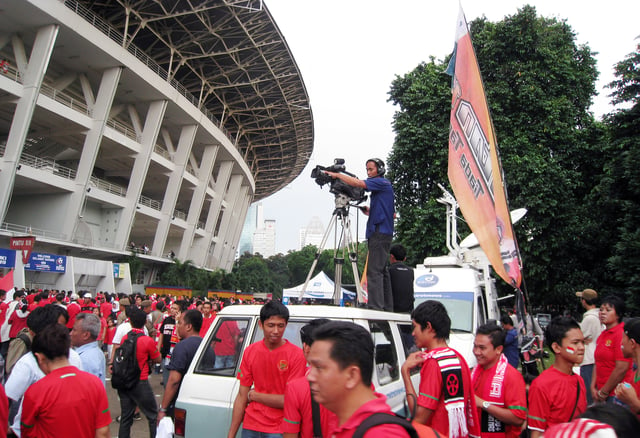
Metro TV at Gelora Bung Karno Stadium, reporting the 2010 AFF Championship
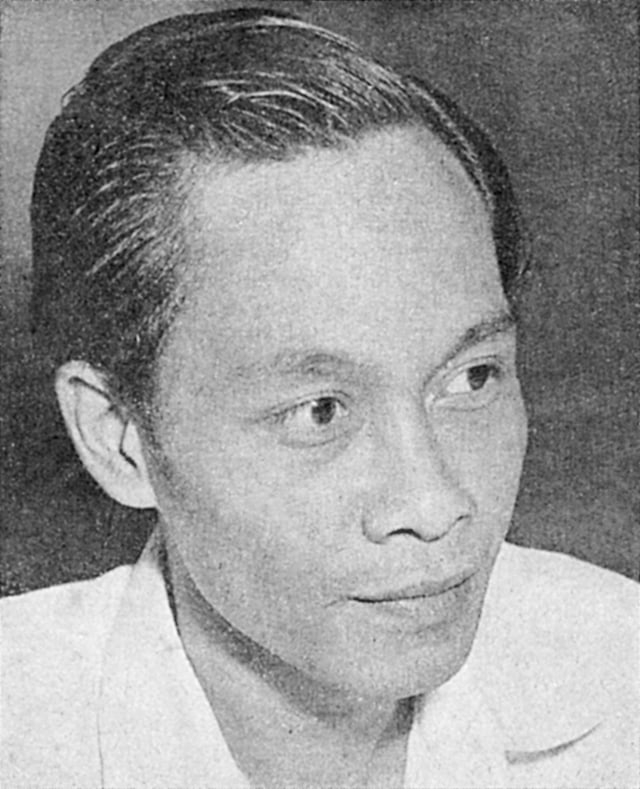
Pramoedya Ananta Toer (c. 1955)
Media freedom increased considerably after the fall of the New Order, during which the Ministry of Information monitored and controlled domestic media and restricted foreign media.[305] The television market includes several national commercial networks and provincial networks that compete with public TVRI, which held a monopoly on TV broadcasting from 1962 to 1989. By the early 21st century, the improved communications system had brought television signals to every village and people can choose from up to 11 channels.[306] Private radio stations carry news bulletins while foreign broadcasters supply programmes. The number of printed publications has increased significantly since 1998.[306] More than 30 million cell phones are sold each year, with 27% of them being local brands.[307]
Like other developing countries, Indonesia began the development of Internet in the early 1990s. Its first commercial Internet service provider, PT. Indo Internet began operation in Jakarta in 1994.[308] The country had 171 million Internet users in 2018, with a penetration rate that keeps increasing annually.[309] Most are between the ages of 15 and 19 and depend primarily on mobile phones for access, outnumbering both laptops and computers.[310]
The oldest evidence of writing in the Indonesian archipelago is a series of Sanskrit inscriptions dated to the 5th century. Many of Indonesia's peoples have firmly rooted oral traditions, which help to define and preserve their cultural identities.[311] In written poetry and prose, several traditional forms dominate, mainly syair, pantun, gurindam, hikayat and babad. Some of these works are Syair Raja Siak, Syair Abdul Muluk, Hikayat Abdullah, Hikayat Bayan Budiman, Hikayat Hang Tuah, Sulalatus Salatin, and Babad Tanah Jawi.[312]
Early modern Indonesian literature originates in Sumatran tradition.[313] Balai Pustaka, the government bureau for popular literature, was instituted around 1920 to promote the development of indigenous literature. It adopted Malay as the preferred universal medium. Prominent figures in modern Indonesian literature include Dutch author Multatuli, who criticised the treatment of natives under Dutch colonial rule; Sumatrans Mohammad Yamin and Hamka, who were influential pre-independence nationalist writers and politicians;[314] and proletarian writer Pramoedya Ananta Toer, Indonesia's most famous novelist.[315][316] Pramoedya earned several accolades, and many considered him to be Southeast Asia's leading candidate for a Nobel Prize in Literature.[317] Literature and poetry flourished even more in the first half of the 20th century. Notable authors include Chairil Anwar (Aku), Marah Roesli (Sitti Nurbaya), Merari Siregar (Azab dan Sengsara), Abdul Muis (Salah Asuhan), Djamaluddin Adinegoro (Darah Muda), Sutan Takdir Alisjahbana (Layar Terkembang), and Amir Hamzah (Nyanyi Sunyi) whose works are among the most well known in Maritime Southeast Asia.[318]
Cuisine
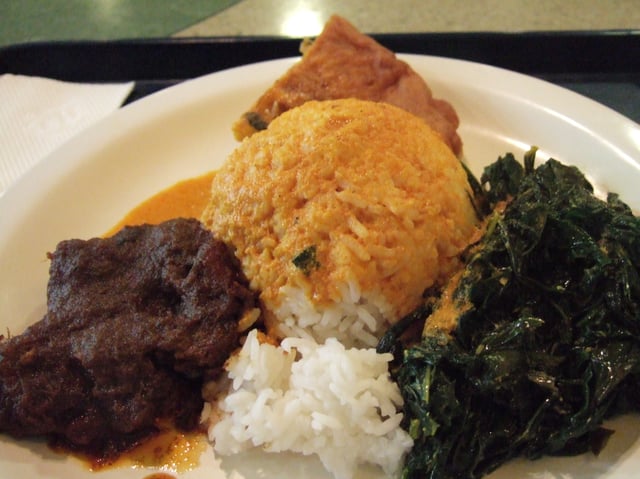
Nasi Padang with rendang, gulai
Indonesian cuisine is one of the most diverse, vibrant, and colourful in the world, full of intense flavour.[319] Many regional cuisines exist, often based upon indigenous culture and foreign influences such as Chinese, European, Middle Eastern, and Indian precedents.[320] Rice is the leading staple food and is served with side dishes of meat and vegetables. Spices (notably chilli), coconut milk, fish and chicken are fundamental ingredients.[321]
Some popular dishes such as nasi goreng, gado-gado, sate, and soto are prevalent and considered as national dishes. The Ministry of Tourism, however, chose tumpeng as the official national dish in 2014, describing it as binding the diversity of various culinary traditions.[322] Other popular dishes include rendang, one of the many Padang cuisines along with dendeng and gulai. In 2017, rendang was chosen as the "World's Most Delicious Food" by the CNN Travel reader's choice.[323] Another fermented food is oncom, similar in some ways to tempeh but uses a variety of bases (not only soy), created by different fungi, and particularly popular in West Java.
Sports
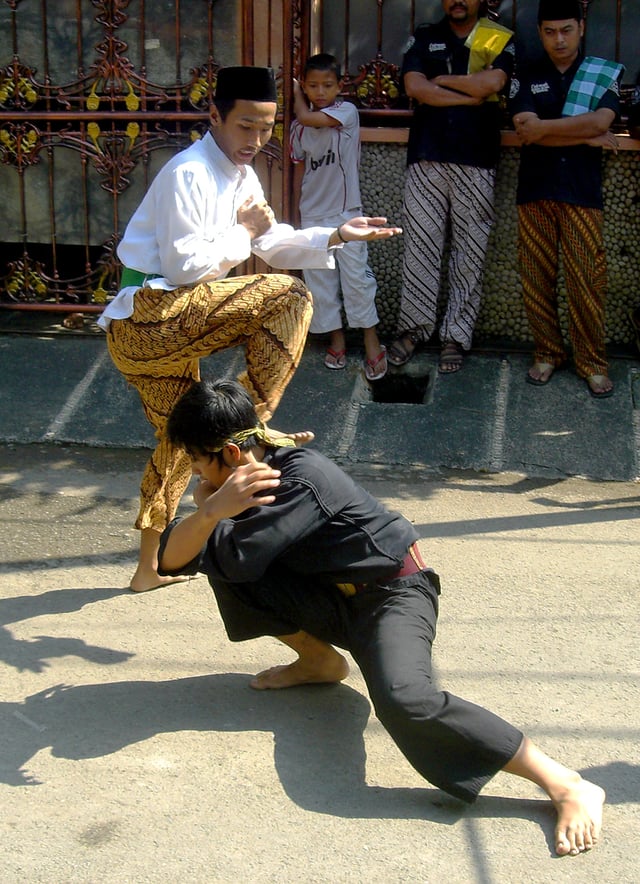
A demonstration of Pencak Silat, a form of martial arts
Sports are generally male-oriented, and spectators are often associated with illegal gambling.[324] Badminton and football are the most popular sports. Indonesia is among the only five countries that have won the Thomas and Uber Cup, the world team championship of men's and women's badminton. Along with weightlifting, it is the sport that contributes the most to Indonesia's Olympic medal tally. Liga 1 is the country's premier football club league. On the international stage, Indonesia has experienced limited success despite being the first Asian team to participate in the FIFA World Cup in 1938 as Dutch East Indies.[325] On the continental level, Indonesia won the bronze medal in the 1958 Asian Games. Indonesia's first appearance in the AFC Asian Cup was in 1996 and successfully qualified for the next three tournaments. They, however, failed to progress through the next stage in all occasions.
Other popular sports include boxing and basketball, which has a long history in Indonesia and was part of the first National Games (Pekan Olahraga Nasional, PON) in 1948.[326] Some of the famous Indonesian boxers include Ellyas Pical, three times IBF Super flyweight champion; Nico Thomas, Muhammad Rachman, and Chris John.[327] In motorsport, Rio Haryanto became the first Indonesian to compete in Formula One in 2016.[328] Sepak takraw and karapan sapi (bull racing) in Madura are some examples of traditional sports in Indonesia. In areas with a history of tribal warfare, mock fighting contests are held, such as caci in Flores and pasola in Sumba. Pencak Silat is an Indonesian martial art and in 1987, became one of the sporting events in Southeast Asian Games, with Indonesia appearing as one of the leading forces. In Southeast Asia, Indonesia is one of the major sport powerhouses by winning the Southeast Asian Games 10 times since 1977, most recently in 2011.
See also
List of Indonesia-related topics
Index of Indonesia-related articles
Outline of Indonesia
Indonesia – Wikipedia book